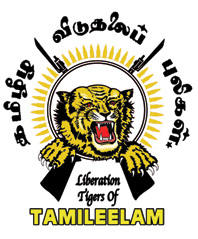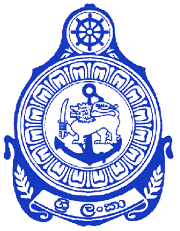
The Liberation Tigers of Tamil Eelam was a Tamil militant organization, that was based in the northern and eastern Sri Lanka. The LTTE fought to create an independent Tamil state called Tamil Eelam in the northeast of the island in response to violent persecution and discriminatory policies against Sri Lankan Tamils by the Sinhalese-dominated Sri Lankan Government.

The Sri Lankan civil war was a civil war fought in Sri Lanka from 1983 to 2009. Beginning on 23 July 1983, it was an intermittent insurgency against the government by the Liberation Tigers of Tamil Eelam led by Velupillai Prabhakaran. The LTTE fought to create an independent Tamil state called Tamil Eelam in the north-east of the island, due to the continuous discrimination and violent persecution against Sri Lankan Tamils by the Sinhalese-dominated Sri Lanka government.

Tamil Makkal Viduthalai Pulikal, previously known as the "Karuna Group", is a political party in Sri Lanka. It was formed by Karuna Amman, a former leader of the Liberation Tigers of Tamil Eelam, after he defected from the organization in 2004. Initially a paramilitary group that helped the Sri Lankan Government fight the Tamil Tigers, the TMVP was registered as a political party in 2007. Under deputy leader Pillayan, they contested their first provincial elections in 2008, winning a majority in the Eastern Provincial Council. Members of the TMVP continue to carry arms under the auspices of the Sri Lankan government, which they claim are for their own safety from the Tamil Tigers, who carry out repeated attacks against them. The group is believed to be working with the Sri Lankan Army. They have been accused of human rights violation by local and international human rights organization.

The Sea Tigers was the naval wing of the Liberation Tigers of Tamil Eelam (LTTE) during the Sri Lankan Civil War. It was founded in 1984. The Sea Tigers had a number of small but effective suicide bomber vessels. During its existence it had gained a reputation as a capable adversary for the Sri Lankan Navy. During the civil war, the Sea Tigers had sunk at least 29 Sri Lankan small inshore patrol boats, 20 Dvora-class fast patrol boats, 3 gunboats, 2 large surveillance command ships, and one freighter.
Vinayagamoorthy Muralitharan is a Sri Lankan politician and former militant. Formerly a fighter for the Tamil separatist group, the Liberation Tigers of Tamil Eelam (LTTE), for over 20 years, Muralitharan later rose to prominence after defecting from the LTTE and forming the Tamil Makkal Viduthalai Pulikal (TMVP), a breakaway faction of the LTTE.

The Sri Lanka Navy (SLN) is the naval arm of the Sri Lanka Armed Forces and is classed as the country's most vital defence force due to its island geography. It is responsible for the maritime defence of the Sri Lankan nation and its interests. The role of the Sri Lanka Navy is to conduct operations at sea for the defence of the nation and its interests and conduct prompt and sustainable combat operations at sea in accordance with the national policies.

The Jaffna lagoon massacre or Kilaly massacre occurred on January 2, 1993, when a Sri Lankan Navy Motor Gun Boat and a number of smaller speed boats intercepted a number of boats transporting people between the south and north shores of the Jaffna Lagoon in the Northern province in Sri Lanka, and attacked them under the glare of a spot light. The estimated number of deaths range from thirty five (35) to one hundred (100). However, only fourteen (14) bodies were recovered. It was reported that other victims of this massacre were burnt along with their boats. The Sri Lankan government claims that the boats were transporting rebel Liberation Tigers of Tamil Eelam (LTTE) cadres.

The Padahuthurai bombing or Illuppaikadavai bombing happened on January 2, 2007, when the Sri Lanka Air Force bombed what they claimed to be rebel LTTE naval base in Illuppaikadavai in Northern Sri Lanka. Sri Lanka Monitoring Mission, the local Roman Catholic bishop, and the LTTE claimed 15 minority Sri Lankan Tamils, including women and children, were killed and 35 injured due to the bombing.

The Tamil Eelam Air Force or Sky Tigers was the air service branch of the Divisions of the Liberation Tigers of Tamil Eelam, who used it against the Government of Sri Lanka. They also called themselves the Tamileelam Air Force (TAF). Though the existence of the Sky Tigers had been the subject of speculation for many years, the existence of the wing was only revealed after an attack in March 2007, during Eelam War IV.

Eelam War IV is the name given to the fourth and final phase of armed conflict between the Sri Lankan military and the separatist Liberation Tigers of Tamil Eelam (LTTE). Renewed hostilities began on the 26 July 2006, when Sri Lanka Air Force fighter jets bombed several LTTE camps around Mavil Aru anicut. The government's casus belli was that the LTTE had cut off the water supply to surrounding paddy fields in the area. Shutting down the sluice gates of the Mavil Aru on July 21 depriving the water to over 15,000 people - Sinhalese and Muslim settlers under Sri Lankan state-sponsored colonisation schemes in Trincomalee district. They were denied of water for drinking and also cultivating over 30,000 acres of paddy and other crops. The fighting resumed after a four-year ceasefire between the Government of Sri Lanka (GoSL) and LTTE. Continued fighting led to several territorial gains for the Sri Lankan Army, including the capture of Sampur, Vakarai and other parts of the east. The war took on an added dimension when the LTTE Air Tigers bombed Katunayake airbase on March 26, 2007, the first terrorist air attack without external assistance in history.

The Eastern Theatre of Eelam War IV started in the Eastern province of Sri Lanka on July 21, 2006, when the LTTE cut off the water supply to rice fields in eastern Trincomalee district. The government claimed total control of the Eastern province after capturing Thoppigala on July 11, 2007, after nearly a year of fighting. Major battles took place at Sampoor, Vakarai, Kanchikudicharu, Kokkadichloai and Thoppigala. Military and civilian deaths were relatively low on both sides. Government forces captured much military hardware from the LTTE during the conflict. The civilians managed to flee the combat zones, and this reduced civilian casualties, while swelling the number of internally displaced people (IDP). The world health organization (WHO) estimated ~200,300 IDPs, and claims that significant progress occurred in resettling them. The LTTE vowed to attack Sri Lanka's military and economic targets across the country to retaliate for the capture of the Eastern province from them. This was stated by the leader of the LTTE's political wing, S.P. Thamilchelvan, in a statement to Associated Press on July 12, 2007.
The Battle of Mullaitivu, also known as the First Battle of Mullaitivu and codenamed Operation Unceasing Waves-1, was a battle between the militant Liberation Tigers of Tamil Eelam and the Sri Lankan military during the Sri Lankan Civil War for control of the military base in Mullaitivu in north-eastern Sri Lanka.

The Battle of Point Pedro was a naval battle that occurred on May 12, 2006 near Point Pedro, Jaffna, Sri Lanka. The Sri Lankan Navy was attacked by a group of Tamil Tiger boats. A group of SLN attack boats was escorting a troop transport, the MV Pearl Cruise II which was carrying 710 soldiers for the city of Jaffna which had been under siege for the previous six years.
The 2008–2009 SLA Northern offensive was an armed conflict in the northern Province of Sri Lanka between the military of Sri Lanka and the separatist Liberation Tigers of Tamil Eelam (LTTE). The battle began with a Sri Lanka Army (SLA) offensive attempting to break through the LTTE defence lines in the north of the island, aiming to conclude the country's 25-year-old civil war by military victory.
Attack on Galle Harbour was a suicide attack carried out by 15 Sea Tigers of the Liberation Tigers of Tamil Eelam (LTTE) on the commercial Galle Harbour and Sri Lanka Navy base SLNS Dakshina in the tourist town of Galle in southern Sri Lanka.
The following lists notable events that took place during 2009 in Sri Lanka.

K. G. Shantha was a senior non-commissioned officer in the Sri Lanka Navy. He was killed in a sea battle against the Sea Tigers, the naval wing of the Liberation Tigers of Tamil Eelam, in the seas of northern Sri Lanka. He posthumously received the Parama Weera Vibhushanaya, the country's highest award for gallantry, and is the second recipient of the medal from the navy.
The Battle of Point Pedro 2007 was a naval battle that occurred on June 19, 2007 near Point Pedro, Jaffna, Sri Lanka. The battle took place when Sri Lankan Navy patrol boats were attacked by a group of Tamil Tiger patrol boats off the shore of Point Pedro.










